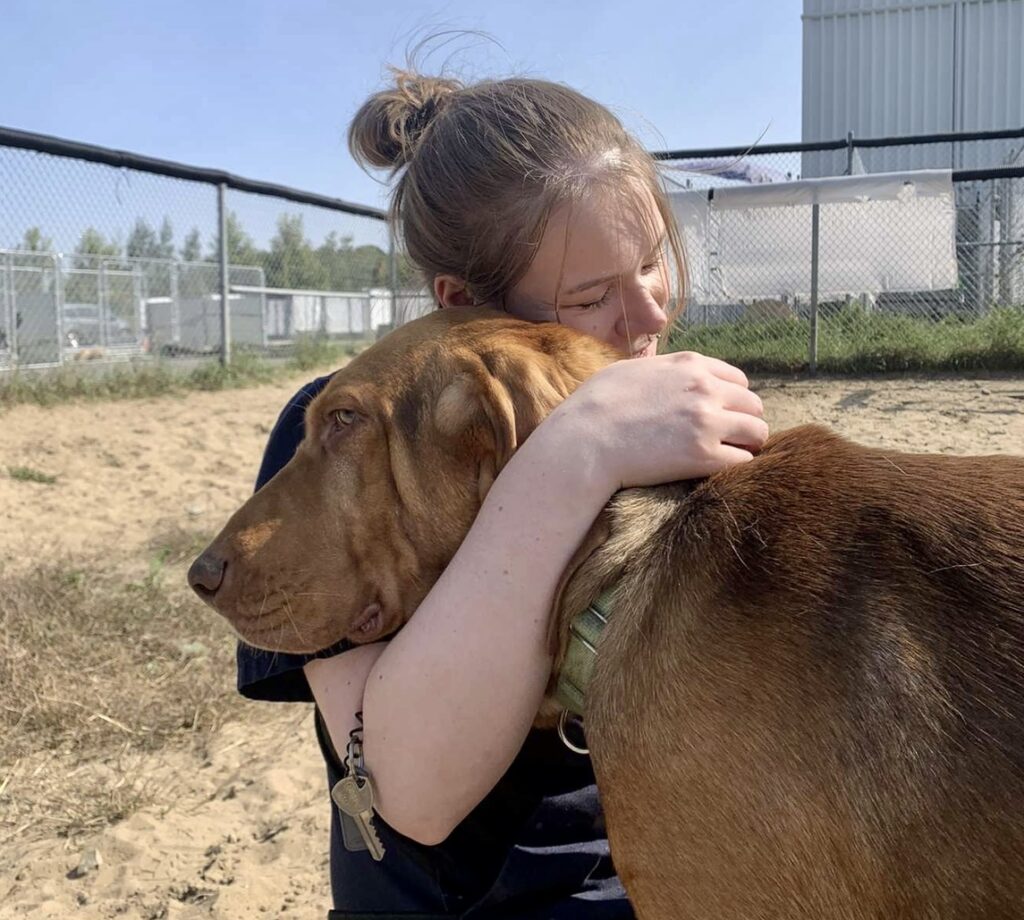Shelters take in thousands of dogs each year, each with their unique background and story. The reasons why these dogs end up in shelters are varied, but often they result from tragic circumstances or difficulties encountered by their owners. Shelters offer a second chance to these animals, where they can find love, support, and a new family to welcome them.
Understanding the behavior of your new companion and knowing how to respond to it is essential to establishing a healthy and harmonious relationship. In this article, we’ll explore some of the most common behavioral problems among rescue dogs, discuss the best ways to address them, and discuss the effect of living in a shelter on rescue dog behavior and health.
What Are the Most Common Behavioral Problems in Rescue Dogs?
Before dogs are ready for adoption, shelter staff evaluate their behavior, which helps spot behavioral problems upon arrival. Shelter staff seek to understand each dog’s needs, preferences, and personality to match them with suitable adoptive families successfully.
- Separation anxiety
Some dogs may become anxious when separated from their owners or familiar surroundings. This type of problem can manifest itself through destructive behavior, excessive barking, or signs of distress when left alone.
- Leash reactivity
Rescue dogs may exhibit excessive reactivity toward other dogs or strangers. It can be caused by a variety of factors, such as lack of socialization, fear, anxiety, or frustration, and can make walks stressful and difficult for both the owner and the dog. Leash reactivity may manifest as barking, growling, or signs of fear when exposed to triggers.
- Resource guarding
Resource guarding is a behavior in dogs where they defend objects, food, spaces, or people that are valuable to them. This may include growling, barking, or even aggressive behavior to prevent other animals or people from approaching their resources. This behavior is often seen when dogs feel threatened by the possibility of losing something they consider valuable.
- Repetitive or stereotypical behaviors
Rescue dogs may exhibit or develop repetitive behaviors, such as excessive licking, tail chasing, compulsive jumping, or circling, in response to stress or boredom. This type of behavior is often seen in dogs that come from puppy mills.
- Fear and shyness
Some rescue dogs may show signs of fear or shyness around humans or new situations, often due to previous bad experiences or a lack of rewarding experience. This may require gradual socialization and desensitization to help the dog overcome its fears.
How to Deal with Rescue Dog Behavior Problems?
In most cases, behavioral problems are attributable to a lack of experience or poorly managed insecurities during the puppy’s socialization period. The dog then develops coping mechanisms to deal with new experiences, which can result in fear, stress, or anxiety.
Before any training, make sure you meet all of your dog’s basic needs and implement strategies to improve his emotional resilience.
Separation Anxiety
Knowing how to deal with separation anxiety is not an easy task. This often requires time, patience, and a tailored approach to each animal to help alleviate symptoms and improve their well-being.
The quickest and most effective method is to contact a dog trainer specializing in separation anxiety. Check the dog trainer’s website to see if they specifically list separation anxiety among the issues they treat. Look for additional certifications, accreditations, or training specifically related to this area.
Here are some simple tips that can help:
- Progressivity: Gradually get your dog used to being alone by leaving him alone for short periods, then gradually increasing the duration. This can help build their confidence and reduce their anxiety. If you leave the house for several hours, it is best to hire a dog sitter or walker to avoid leaving your dog alone.
- Routine: Establish a consistent daily routine for your dog, including meal times, play times, and walks. A predictable routine can help reduce stress and anxiety.
- Enrichment: Provide your dog with interactive games to keep him entertained while you are away. This can help keep your mind occupied and reduce anxiety.
- Exercise: Make sure your dog gets enough exercise every day. An energetic walk or play session before heading out can help release energy and reduce anxiety.
- Desensitization Training: Train your dog to associate your departure with positive experiences by giving him a special treat or toy every time you leave. This can help change their negative association with your departure into a positive experience.
Leash Reactivity
There are several online courses for reactivity in dogs. These courses can provide information, advice, and practical techniques for understanding and addressing reactivity, often through videos, course modules, and downloadable resources. Participants can learn to recognize signs of reactivity, implement desensitization and counterconditioning exercises, and develop behavior management strategies to help their dog become calmer and more confident in social situations.
Before choosing an online course, it is recommended to check the qualifications and experience of the trainers, as well as the reviews and testimonials of previous participants to ensure you choose a reliable resource adapted to the specific needs of your dog.
Here are some simple tips that may help you:
- Basic training: Teach your dog basic commands such as a recall cue, which can help him focus on you in stressful situations. Call your dog back every time he stares at a dog or person and walk in the opposite direction to distance yourself.
- Distraction: When approaching other dogs or people, wait until your dog has seen the trigger, and use his favorite treats to distract him and teach him to associate these encounters with positive experiences.
- Positive reinforcement: Reward your dog with his favorite treat every time he looks at you to encourage him to keep his focus on you and adopt appropriate reactions in social situations.
- Respect his comfort zone: Avoid situations where your dog might feel threatened or stressed and learn to recognize early signs of reactivity, such as staring and rigid posture to avoid them.
- Walking on a loose leash: Tension on the leash can make walks more stressful. To teach your dog to walk on a loose leash, consult this article: “Loose Leash Walking: The Quick Guide”.
- Consult a professional: If your dog’s reactivity persists despite your efforts, consult a dog trainer for specific tips and techniques to help your dog overcome his overreactions.
What not to do with a reactive dog on a leash:
- Correct him if he reacts. Using physical or verbal corrections can make your dog’s anxiety or fear worse, and may even lead to more aggressive behaviors in the long term.
- Give food to prevent his reaction. This can unintentionally reinforce their reactive behavior.
- Wait until he stops barking to offer him treats. He might interpret receiving treats as a reward for barking, which would reinforce this unwanted behavior.
- Have him sit down when he sees a trigger. This does not address the underlying cause of his behavior. Additionally, asking a dog to sit in stressful situations can cause more frustration and fear.
Resource Guarding
Resource guarding is a natural behavior in dogs. It is therefore normal for them to protect a place, an object, a person, or food that they consider valuable. However, in some dogs, their perception of what is valuable may be incorrect, which can lead to excessive or inappropriate protective behaviors. This is why it is important to understand and manage this behavior appropriately to ensure the safety and well-being of everyone.
It can be easy to manage this behavior depending on the severity of the reactions. For some dogs, simply putting them in a separate room or a crate when they eat may be the solution.
Here are some simple tips:
- Prevent Conflict: Avoid situations that might trigger your dog’s resource guarding by limiting access to objects or spaces he considers valuable when you cannot supervise him.
- Obedience training: Train your dog to obey basic commands like “leave it” or “drop it” to teach him to share his resources on demand.
- Exchange: Teach your dog to exchange an object he is protecting for a high-value reward, such as his favorite treat or a special toy, to encourage voluntary sharing.
- Prevention: Avoid forcibly removing objects from your dog’s mouth or disturbing their personal space, as this may worsen resource guarding.
- Consult a Professional: If your dog’s resource guarding becomes a serious problem, consult a dog behavior professional for specific advice and management strategies tailored to your situation.
To find out more, consult this article: “Resource Guarding: The Complete Guide”
Repetitive or Stereotypical Behaviors
- Identify the cause: Try to determine what is triggering your dog’s repetitive behavior. Is it related to boredom, anxiety, stress, or another factor? Understanding the underlying cause can help you choose the best approaches to manage it.
- Environmental enrichment: Provide your dog with a stimulating environment with interactive toys, mental and physical activities, and enriching walks and play sessions. This can reduce boredom and frustration which can lead to repetitive behaviors.
- Training and Redirection: Teach your dog more appropriate alternative behaviors, such as fetching a toy, or giving an interactive toy, like a Kong or a licking mat, with tasty treats inside. You can also give your dog something to chew on like a bully stick or a pig ear. Redirect his attention to positive activities when you notice repetitive behaviors.
- Consider physical activity and mental stimulation: Make sure your dog gets enough physical exercise and mental stimulation every day. Regular physical activity can help channel energy and reduce repetitive behaviors.
- Consult a professional: If your dog’s repetitive behaviors persist despite your efforts, consider consulting a veterinary behaviorist or dog behaviorist for advice and recommendations specific to your situation.
Fear and Shyness
- Create a safe environment: Make sure your dog’s environment is safe and free from sources of stress. Create a quiet space where he can retreat and feel safe.
- Gradual Socialization: Gradually expose your dog to new people, animals, sounds, and environments, using gentle, positive socialization sessions. Be patient and don’t force interactions.
- Positive reinforcement: Use rewards like treats, cues, and petting to encourage courageous and confident behaviors in your dog. Reward him when he faces his fears or behaves relaxed in social situations.
- Avoid punishment: Avoid using punishment or forcing your dog to face his fears, as this can make his anxiety and shyness worse. Instead, offer support and reassurance to help them overcome their fears gradually.
- Consult a professional: If your dog’s fear or shyness is interfering with his quality of life or well-being, consider consulting a veterinary behaviorist or dog behaviorist. They can provide specific tips and techniques to help your dog overcome their fears effectively and safely.
How Does Living in a Shelter Affect Dogs?
Shelter dogs often lack enrichment for several reasons. First, shelters can often be underfunded, meaning they have limited resources to provide stimulating activities for dogs. Additionally, due to staff shortages, employees may struggle to devote enough time to each dog to provide them with enriching activities.
Also, shelter facilities may be limited in terms of space and equipment, making it difficult to provide stimulating environments for dogs. Finally, some dogs may have specific enrichment needs due to past trauma or behavioral issues, requiring additional attention and specific resources.
How Does the Shelter Affect the Health of Dogs?
Living in a shelter can have several impacts on the health of dogs. As you probably know, the shelter environment can be stressful for them. This can lead to increased stress levels and changes in their physiology, such as increased levels of the stress-related hormone cortisol.
Several studies prove that prolonged stress can contribute to the onset and worsening of various chronic or degenerative diseases. Thus, it is associated with the development of cancer, diabetes, and various cardiac, neurological, respiratory, and renal diseases.
Additionally, stress can impact the dog’s digestive system, leading to problems such as gastrointestinal upset, diarrhea, or vomiting. These problems can also contribute to a loss of appetite, worsening the negative effects on the dog’s health.
Also, shelters can often be overcrowded, which increases the risk of infectious diseases spreading between dogs. Lack of adequate exercise and mental activity in a shelter environment can also contribute to health problems.
How Does Shelter Affect Dogs’ Immune Systems?
Chronic stress associated with shelter life can weaken their immune system, which can increase the animal’s susceptibility to various infections and diseases. Stress releases hormones like cortisol, which, when produced in excess over a long period, can suppress immune function.
Additionally, shelters are often crowded environments where dogs are at risk of infection and disease. Stress, confined living conditions, and social interactions with other dogs can all contribute to an increase in vulnerability to infectious diseases.
Finally, lack of exercise, adequate rest, and proper nutrition in a shelter can also weaken dogs’ immune systems, making them more likely to get sick. It often happens that a dog newly arrived at the shelter has difficulty eating for a few days due to stress, which can weaken their immune system.
How does the shelter affect the dog’s behavior?
Some dogs may develop behavioral problems, such as anxiety and depression, due to the stress and boredom associated with shelter life. They may also lose interest in certain things they used to enjoy doing.
Living in a shelter can have a significant impact on rescue dog behavior, in part due to allelomimetism. This phenomenon describes the tendency of dogs to imitate the behaviors of their peers. So, a dog may adopt these behaviors by seeing other dogs display them.
For example, if a dog sees other dogs barking excessively, he may also start barking even if he didn’t express this behavior before. Likewise, if he sees other dogs relieving themselves in their enclosure or even pulling on the leash, he may begin to exhibit these behaviors as well.
However, the opposite is also true. If a dog observes other dogs behaving calmly and confidently, this can positively affect their behavior and encourage them to adopt similar behaviors.
In conclusion, there is no denying that living in a shelter and experiencing behavioral problems can be significant challenges for dogs. These difficulties can have a significant impact on their health and general well-being. However, it is crucial to recognize that there is still much to learn to help them adapt better, feel fulfilled, and find happiness within their environment.
Bibliographic sources:






